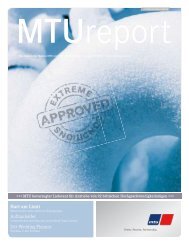Create successful ePaper yourself
Turn your PDF publications into a flip-book with our unique Google optimized e-Paper software.
It starts with a rectangular cast-iron blank<br />
– and a design drawing. The drawing shows<br />
the precise dimensions. From those basic<br />
materials a cylinder head is produced within<br />
one and a half days. But how?<br />
A cylinder head has to be able to withstand<br />
temperatures as high as 700°C and ignition<br />
pressures over 200bar when the engine is<br />
running. It closes off the top of the cylinder and<br />
forms the upper part of the combustion chamber.<br />
Fitted inside it are the inlet and exhaust valves<br />
and the fuel injector. So the cylinder head<br />
not only has to be made of absolutely top<br />
quality material, it also has to be precision<br />
manufactured.<br />
Virtual production<br />
The drilling and milling operations start not on<br />
a machine tool but on a computer. Every single<br />
drilling and cutting operation performed by the<br />
machining center to turn the metal blank into<br />
a finished cylinder head is programmed and<br />
simulated beforehand using the ProEngineer and<br />
NCSimul software. Bernd Scherer is an expert in<br />
such virtual machining. He is a production planner<br />
and NC coordinator at <strong>MTU</strong>. He describes the<br />
programming procedure thus: like the machine<br />
tool operator, he first selects the right tools for<br />
the specific cutting and drilling operations from<br />
the tool management system on the computer.<br />
Then he places the three-dimensional virtual<br />
cylinder head on the virtual machine table and<br />
secures it with the virtual workholding fixtures.<br />
With a few mouse-clicks he tells the ProEngineer<br />
software where and how much of the surface<br />
is to be cut away and where which holes are to<br />
be drilled. “The system helps to make sure you<br />
are always using the right dimensions,” Scherer<br />
explained. Then he programs the next step. “The<br />
tricky part of programming is finding the best<br />
possible sequence of movements on the machine<br />
tool so that all surfaces are efficiently machined<br />
and an economically and technologically perfect<br />
program is produced,” the expert added.<br />
Computer simulation<br />
To check whether the program is right, he then<br />
simulates the machining of the cylinder head on<br />
the computer. He can then see exactly how the<br />
tool moves and where there might be collisions<br />
between the machine and the workpiece. That is<br />
a major benefit because in real-world production,<br />
any collision can cause substantial damage to the<br />
machine, the tool and the machined part.<br />
Cylinder head step by step<br />
Then it is time for the real thing. The virtual<br />
machining program created in ProEngineer<br />
is transferred to the real machine tool. To be<br />
precise, two machine tools are used to transform<br />
the metal blank via a number of machining<br />
stages into a finished cylinder head. A machine<br />
operator places the cast cylinder head blank<br />
on the workholding fixture on the first machine<br />
table. He closes the large sliding doors of the<br />
milling machine and starts it up. From this<br />
point the process proceeds automatically. A<br />
milling cutter runs over the surface and cuts<br />
away the metal bit by bit. Hardly anything of the<br />
operation is visible, however. Coolant-lubricant –<br />
required, as the name suggests, for cooling and<br />
lubricating the cutting tool – splashes all over<br />
the machine tool windows. The first machining<br />
center machines the top and bottom of the blank<br />
in turn on its first and second machine tables.<br />
Afterwards, the machine operator checks the<br />
most important drilling, milling and clearance<br />
dimensions to make sure the process and the<br />
tools are working properly. The part then moves<br />
on to the second machining center where the<br />
surfaces on the sides are machined and drilled.<br />
The cylinder head is then cleaned in a washer.<br />
Afterwards, a production worker inserts the valve<br />
guides and seats into the drilled holes. Next, the<br />
casting is checked for flaws, cracks and other<br />
damage, cleaned and deburred.<br />
Multi-stage machining<br />
The second machining center finish-machines the<br />
valve guide holes and valve seat recesses at the<br />
same time so that they are exactly flush. Checking<br />
the geometry and dimensions to an accuracy<br />
of a hundredth of a millimeter after machining<br />
guarantees that the valves function perfectly. A<br />
second washing stage ensures that the technical<br />
cleanliness requirements are met. Finally, an<br />
assembly worker fits the protective sleeve and<br />
plugs. If the part passes the subsequent gastightness<br />
test, it is ready for the last production<br />
stage – the fitting of the inlet and exhaust valves<br />
which respectively let the air into and exhaust out<br />
of the combustion chamber. Then the cylinder<br />
head is fully kitted out for a long life of high<br />
performance operation on an engine.<br />
Words: Katrin Beck, Pictures: Robert Hack<br />
To find out more, contact:<br />
Bernd Scherer, bernd.scherer@mtu-online.com<br />
Tel. +49 7541 90-3464<br />
The cylinder heads arrive at <strong>MTU</strong> from the foundry<br />
as cast blanks. Before being passed on for assembly,<br />
their surfaces have to be machined and holes drilled.<br />
An <strong>MTU</strong> production worker deburrs the<br />
machined part, removing rough edges and shavings<br />
from the workpiece.<br />
<strong>MTU</strong> Report 03/12 I 27



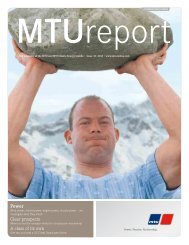

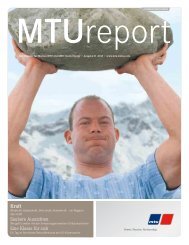
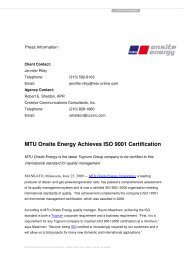

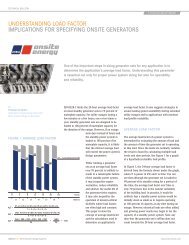


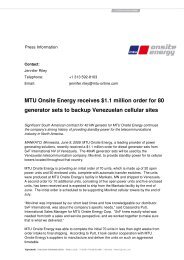

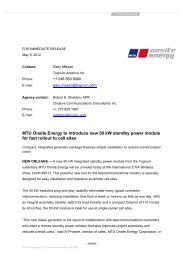

![Full power range of diesel generator sets [PDF] - MTU Onsite Energy](https://img.yumpu.com/28297693/1/190x253/full-power-range-of-diesel-generator-sets-pdf-mtu-onsite-energy.jpg?quality=85)
